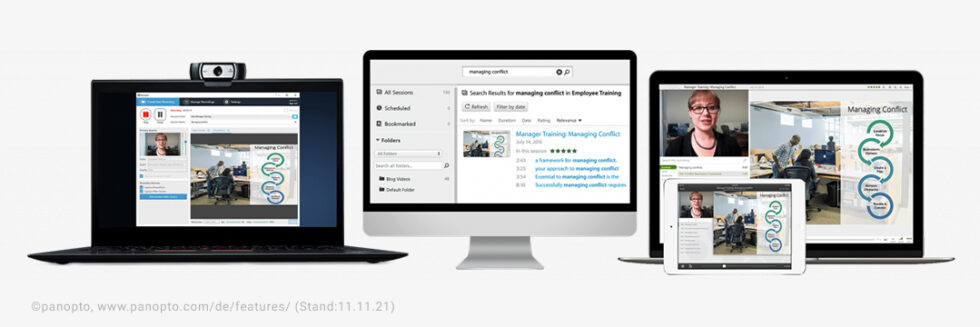The demand for multimedia content and e-learning offerings in education continues to grow strongly. New teaching formats increasingly rely on the use of digital technologies to create modern and flexible conditions at universities. Digitalization, new teaching methods and social changes such as the recent Corona pandemic are fostering this development. Video-based learning formats in particular can benefit students’ learning experience through their vividness and contemporary form. For the regulated creation, storage and delivery of the content, it requires a comprehensive video management platform that makes video content available on demand or enables the transmission of live streams. It provides an effective way to deliver knowledge, regardless of time and place.
Sample applications and functions

With a video management platform, instructors and students can easily integrate video into their work, share it with each other, and manage it through a graphical user interface. These are either purely software-based or require additional devices such as a audio visual recorder. Common platforms can be integrated directly into well-known learning platforms such as Moodle and Ilias to enhance them with video content. The applications and functions of such offerings are diverse. Centrally stored and accessible from anywhere, videos enrich blended learning or flipped classroom formats. Students work on content online and prepare themselves independently for lectures, which can then be discussed later in presentation lectures and deepened as required. Teachers can easily create video lessons or presentations via their own laptops and upload them to the media library of the software environment. The upload can be automated. Lectures can also be recorded and made available to a large number of students for follow-up. This is particularly interesting for distance universities. It gives students more flexibility in terms of time and space when organizing their studies. They can also use a video management portal to work on assignments in video format, share them with other students, and submit them to their instructors. The systems can also be used to record lectures and seminars. They also offer the option of streaming events live over the Internet to a specific target group. In this way, hybrid event forms can also be realized and a large number of participants can be reached beyond the spatial capacities. Additional connected video and audio sources can be accessed during recording. The software automatically recognizes the external devices and can record them. In this way, multiple perspectives can be used to highlight other elements in the room and thus add variety to the event. Of course, the own screen can also be split in the video or several signals can be shown at the same time in split screen. Depending on the platform used and the scope of services, interactive elements are added. These include commentary functions, survey tools, or even the division of participants into so-called breakout rooms for smaller group discussions during an online event. Before uploading, videos can be edited within the software using an editing tool. They can be quickly embedded on other websites or sent as links. For retrievability, some programs automatically tag the videos with keywords based on the content to be easily found using the search function. To ensure that everyone can understand the content, the software can automatically generate subtitles for the video in question. Depending on requirements, it is possible to define access to videos and functions within the program for different user groups via user management. This allows administrators to create clear processes and organize orderly use. Leading manufacturers of such video management systems often also offer complete digital learning environments that are specially designed for use in the education sector.
Special features when procuring video management systems in higher education

As this brief functional overview already points out, there are many aspects to consider when procuring a video management system. From our project experience, we know that at the beginning of a project the exact expectations and requirements for a system to be procured or available options are not clear or known. Especially for a possibly necessary public tender, however, it is urgently necessary to know the specific requirements for your purposes and to specify them clearly. We can advise you independently in this process right from the start and help you to introduce or change a video management system. To this end, our experts conduct comprehensive requirements workshops together with our customers to clarify important prerequisites and determine their exact needs. Together, we define the use cases and what they want to do with the new technology. The range of functions is one of many criteria that are decisive for a successful tender. Established providers may have a lot to offer, but are sometimes not as flexible in responding to the customer’s special requests.
Other important basic questions must be clarified in advance:
What kind of procurement and operating model do you want to pursue? Do you want to buy licenses for the selected software and provide installation, hosting and operation from within your own IT department, or do you want a comprehensive “as a service” package? In this case, the external service provider provides the IT infrastructure, takes over hosting of the platform on its servers, and completely takes care of the operation of the system in return for regular fees. With regard to data protection, there is also a requirement that hosting must take place within the EU. This already eliminates some providers. In addition to implementing the new platform, do you also want to transfer data from existing systems? If so, how high is the data volume of the existing data, what formats can be expected, and how high are the migration and storage requirements? What are your support requirements? Do you need training for your users? How many user licenses do you need? What volume of regular content do you expect? Depending on requirements and performance, hardware must also be specified and put out to tender. In addition to the software, you may need a separate recorder, cameras, microphone and room sound systems, or even a video console to control the content. Some providers supply their own hardware or use certified hardware from other manufacturers. As soon as all important details have been clarified, we can evaluate possible systems on the basis of the requirements. For the invitation to tender, we prepare a specification sheet that contains a precise description of the project, a list of requirements and an overview of the scope of services, including functions and services. An important topic in this context is the required availability of the system and thus also the stored service levels and operational requirements. In addition, we create a criteria catalog that is used to evaluate the incoming offers. Clear award criteria are essential for the tendering process. The criteria are divided into different categories. Mandatory criteria are exclusion criteria. Providers who do not meet these criteria are automatically eliminated from the bidding process. They are a condition for the implementation of the requirements. Optional criteria are queried from potentially eligible service providers. Based on the results, a qualified decision can then be made in favor of a bidder – and nothing stands in the way of implementing your new video management system. If you have any questions about this or other technology topics, please feel free to contact us directly at any time.
Author: Felix Niedrich, Editor macom GmbH
